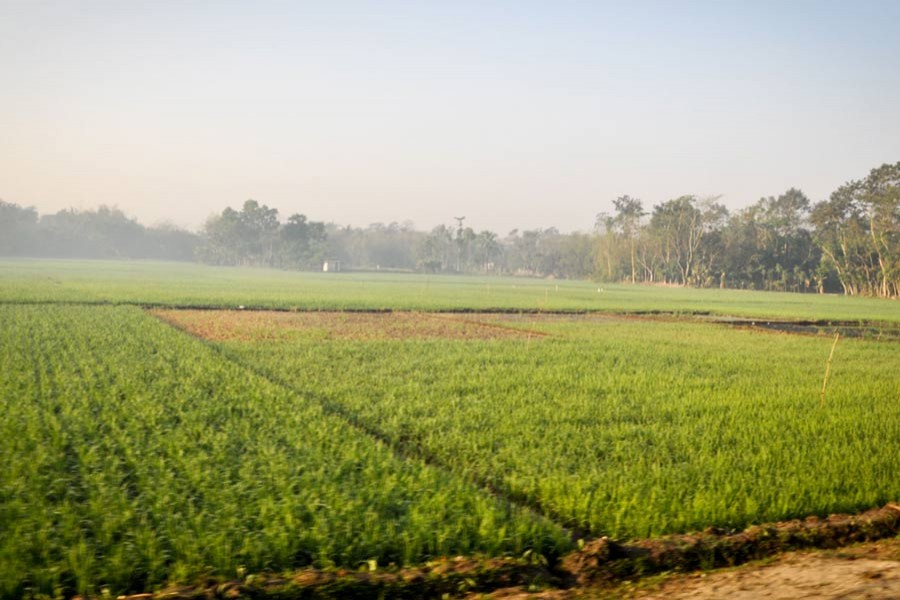My destination was Rajshahi, located on the north bank of the Padma River in Bangladesh, near the border with India. Here one can understand what more likely than not encouraged Rabindranath Tagore to compose the song Amar Shonar Bangla (My Golden Bengal).
Maybe, Tagore, like me, encountered the fully-bloomed paddy fields, the aroma of the mango forests, and the splendid fire of a hundred dusks unchallenged by a solitary cloud.
Unfortunately, Bangladesh is also highly exposed to extreme weather events and prone to flash flooding, drought, cyclones, and saltwater inundation due to tidal surges. If agriculture at risk, it can adversely impact livelihoods and cause food insecurity.
When considering options to reduce the financial drain on farmers and local communities, ands cut down on post-disaster government expenses, crop insurance is a valuable climate adaptation tool. It offers farmers the capacity to plan and put aside some money for the long term against the rainy days of lifes when harvests are suddenly damaged or destroyed.
Furthermore, access to protection enables access to credit. It allows farmers to invest in modern technology that lifts productivity and incomes.
ADB has piloted weather index-based crop insurance for rice farmers in three areas of Bangladesh, including drought-prone Rajshahi. The pilots feature three innovative components.
Parametric weather indices use climate information generated by the Bangladesh Meteorological Department. These indices decide the trigger points for payout, for instance, when the precipitation rises above or dip under certain levels.
Automatic weather stations (AWS) help activate timely claims settlement after the occurrence of a disaster. Over 9,500 small farmers were insured through Sadharan Bima Corporation.
Mobile banking services' tie-up with bKash enabled efficient and transparent collection of insurance premium and payment of claims. The premium contribution was shared in the ratio of 50:25:25 among the farmers, the government, and the project financier.
During my interactions in Dhaka with insurance companies, banks, and policymakers on their impressions about the pilot, I sensed emerging consensus on the following:
Crop insurance is a useful instrument to transfer financial risk away from the government and farmers. Insurance protection needs to include crops, livestock, and aquaculture, while the market requires enabling policy and regulatory settings to develop.
Even though the pilot has been a success, an impact study on the benefits of index insurance needs to be carried out to look at how it has prompted rural development.
With more pilots, insurers can learn more about designing weather indices and correlating them with yield losses.
Given the sizable financial exposure associated with correlated losses, insurers' low experience and the lack of access to reinsurance on competitive terms, the feasibility for setting up an agriculture insurance pool is still unclear.
A public-private partnership could frame the basis for scaling up sustainable agricultural risk protection. While the government should continue to cover the recurrent losses through budget contingencies together with reserves, (re) insurance options should also be considered.
Investments in funding weather infrastructure-such as AWS for data collection and measurement-and advancing a risk market infrastructure for analysis, forecasting, and early warning are both vital to develop risk financing products.
Bundling agricultural insurance with farm credit and farm inputs should be considered to protect farmers in the event of crop failure. It will also help stabilise farm incomes by restoring the credit eligibility of a farmer for the following season.
Scalable financial technologies like blockchain need to be introduced to connect value chain financing with risk management. Future pilots can use smart contracts for crop insurance and supply chain traceability, so farmers can make educated decisions to anticipate and prepare for contingencies. The right technologies can also help lessen distribution and administration costs.
Later, during my discussions with the farmer beneficiaries, it was reassuring to hear from them that crop insurance is not a liability, and that it gives benefits during unforeseen circumstances. However, the insurers need to increase the speed of disbursement of claims. Other key takeaways were:
-- Microfinance institutions that offer crop credit loans encourage social participation and help create awareness about crop insurance, beyond delivering a bundled product at the farmers' doorstep.
-- Players in the value chain such as seed distribution companies can be potential partners.
-- A blend of both indemnity and index-based products ought to be on offer. Index-based products work well for general events that trigger adverse weather that can be independently verified and measured (rainfall) but offer little protection against localized events such as a hailstorm. Likewise, index-based products may not capture some aggregate events that affect a whole area (disease outbreak).
-- Involving farmers in project design can help developing packages tailored to their perceived opportunities and risks.
-- Pilots contribute to building deep relationships, alternate distribution methods, and transparency through continuous validation and improvement.
-- Farmers are open to embracing financial technology, given the benefits experienced in paying premiums and instant cashing out of claims using mobile banking.
One way to increase uptake is with subsidies or having a compulsory insurance product attached to a bank loan. Farmers conveyed that without the current level of subsidies, the premium is unaffordable. At the point, when asked how they would respond if subsidies are done away with, a young farmer got up and said:
"We are grateful to you for teaching us the benefits of having an umbrella. We will try everything within our means to continue to hold it over our heads."
When the great Moroccan traveler Ibn Battuta visited present-day Bangladesh around 1330 CE, he described it as "a country of great extent, and one in which rice is extremely abundant. Indeed, I have seen no region of the earth in which provisions are so plentiful."
If today's farmers hold similar levels of resolve, that description might still hold good someday soon.
The writer is Principal Financial Sector Specialist, Sustainable Development and Climate Change Department, Asian Development Bank. [email protected]


